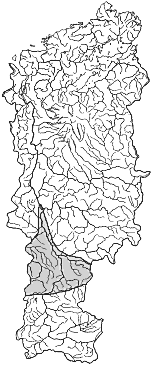|
|
| Main |
| Systematic List |
| Photo |
| Central Siberia |
| Guest book |
| Awards |
| SEARCH |
|---|
|
|
Sylviidae |
|---|
Garden Warbler Sylvia borin (Boddaert, 1783)
|
 Relatively big specimen (more than a sparrow), upper part is gray-brownish, lower part is a bit lighter, color of a tail is constant. Careful behavior is typical. Emergency signal is "chak-chak". Doesn't fly while singing. Nest is located on the shrubs and lower parts of the trees, polypodium. Average is height is 10-30 cm up to 1,5 meter. Looks like a deep bowl. 4-5 eggs are in the nest. Color is variable - whitish background with gray-brownnish or brownish spots. Usuall food are bugs and caterpillars. It kills many forest and fruit-tree pests. The Garden Warbler is a European species that is distributed east to the Yenisey River along the southern edge of the forest and forest-steppe zones; it is expanding eastwards. In the early part of the century only two records were known from the Krasnoyarsk Territory: one specimen each collected from near Krasnoyarsk and Yeniseysk (Tugarinov and Buturlin 1911). The species was not found at all east of the Yenisey. But since then, the species has spread across areas of forest-steppe, subtaiga, southern taiga, and mid taiga in Central Siberia. Garden Warblers have not been found in the Minusinsk depression nor in the Sayan Mountains except for in the foothills near Krasnoyarsk, where the species is a rare breeder in dense young aspen groves on deserted fields on the edge of the taiga (Yudin 1952). According to D.V. Vladyshevsky, the species is rather common as a breeder in Akademgorodok, a subdivision of Krasnoyarsk, breeding in forests of low density and medium moisture with a developed understory. In subtaiga in the Bolshoy Kemchug River basin, the species is common (1-2 birds/km2), as it is in the Poyma River basin (2-4 birds/km2) (Ravkin et al. 1988). To the north, in the southern taiga subzone, breeding Garden Warblers are ubiquitous but show a marked preference for aspen groves. Sometimes they reed on islands and in shrubby growth along the Angara River near the settlement of Motygino (Syroechkovski et al. 1978). The birds are rare in the Angara basin in a majority of the taiga zonal habitats but are abundant in clearcuts recolonized by pines and on forest borders with aspen stands (10-12 birds/km2) and are common in fir forest edges with aspen groves, in birch and in aspen groves, on bum sites, and in forests destroyed by invasions of Dendrolimus sibiricus (6-8 birds/km2) (Vladyshevsky 1975, 1980; Vladyshevsky and Shaparev 1976). In Yenisey southern taiga (59°-60° N) the species is found mainly occupying old-growth deciduous forests with a rich understory, including floodplain willow groves. Other sites where the species abundant include the upper Yenisey floodplain near Fomka (14-18 birds/km2) as well as mixed forests broken up by clearings near Pogodayevo (11 birds/km2) (Bursky and Vakhrushev 1983). In the southern part of the Yenisey mid taiga the species has been recorded as a common breeder — 2 birds/km2 — in the Yenisey floodplain where it occupies the edges of groves of tall willows. But further north, near Verkhne-Imbatskoye and Alinskoye, as well as beyond the Yenisey valley itself, the species has not been recorded at all. Occasionally, since 1974, males have been registered in Mirnoye at the end of June and the beginning of July. Further, since 1978, 1-2 pairs have nested every year in the same habitat, i.e., in tall willows on a levee lining the west side of the river. And in 1982 and 1983, a pair also bred in a birch-alder forest on the narrow floodplain on the east bank of the Yenisey near the edge of the forest stand. In 1980, a pair settled in a young birch stand on a burned area bordering the overgrown edge of a bog 25 km east of the Yenisey. Breeding birds arrive between June 4 and 6 as recorded over a period of three years. Young birds are found at the end of July, and the final birds of the on are seen between August 23 and September 2. |
[Back] |
|
|
|
|
Сайт разработан и поддерживается кафедрой прикладной экологии и ресурсоведения СФУ
